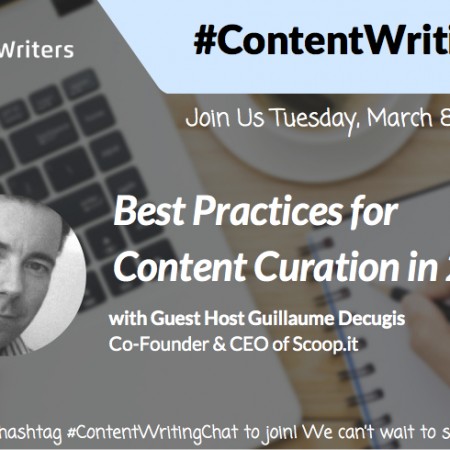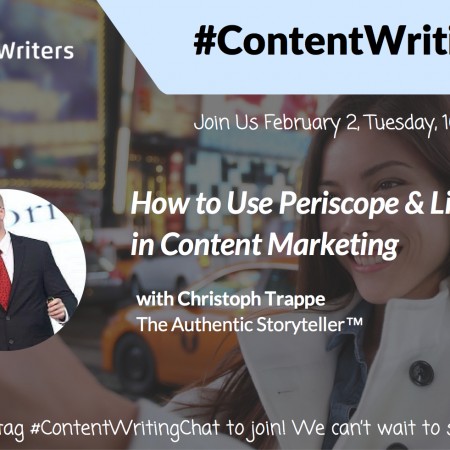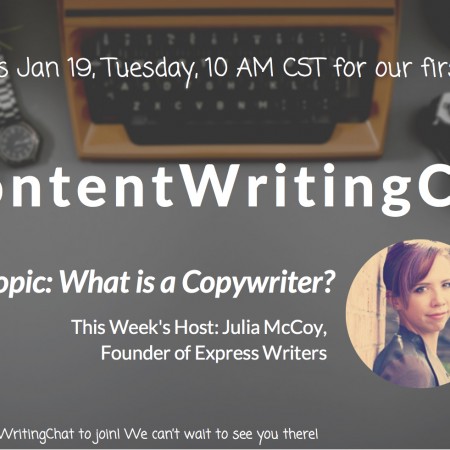#ContentWritingChat March 22 Recap: Strategies for Finding/Creating Great Media to Go With Your Content with Kelsey Jones
Did you miss this week’s #ContentWritingChat? Well, you’re in luck because we have a full recap! We talked all about finding and creating media (images, videos, and audio) to go with your content. Keep reading for some of the highlights from the chat and start implementing these tips into your online presence. #ContentWritingChat March 22 2016 Recap: Strategies for Finding/Creating Great Media to Go With Your Content Join us Tuesday, March 22nd at 10 AM CDT for #ContentWritingChat with @wonderwall7 as our guest host! pic.twitter.com/wTvS9LZvjF — Express Writers (@ExpWriters) March 15, 2016 For this week’s chat, our guest host was Kelsey Jones. Kelsey is a Marketing Strategist and the Executive Editor at Search Engine Journal, where our CEO Julia is a guest contributor. We love SEJ and we were honored to have Kelsey join us! She shared her best tips on creating great media to go along with your blog posts, social media, and more – our hour was packed full with information! Headed out. First time I have to leave my own chat LOL 🙁 But my sick baby needs me! #ContentWritingChat is in good hands w/ @redheadrachel — Julia McCoy (@JuliaEMcCoy) March 22, 2016 Julia was unable to make it, unfortunately, due to her baby toddler being sick – but we still managed to have fun. 😉 Q1: How do you find or create the perfect video/image/audio? When we’re creating media, we always want to ensure it’s our absolute best! How do you do that? It seems the participants of Tuesday’s chat were pretty unanimous with their answers. A1 It takes time to figure out what works best w/audience. Find a tool that makes it easy to search for media. #contentwritingchat — Kelsey Jones (@wonderwall7) March 22, 2016 A1. We create the perfect video/image by planning out what kind of message are we trying to get across to our audience. #contentwritingchat — Village Print&Media (@village_print) March 22, 2016 A1- I monitor what styles have resonated w/ key my audience, then use free sources like https://t.co/V6j1VlFCXi, Canva #contentwritingchat — Hannah Chapple (@HannahChapple) March 22, 2016 Kelsey, Village Print & Media, and Hannah all agree that you need to keep your audience in mind when creating images, videos, and audio content. Your audience is the most important thing and you want to ensure you’re creating media that will resonate with them. Plan your message and figure out what your audience is most drawn to. Q2: What are some tips on creating great images to share in blog posts? When it comes to blog posts, it’s important to add at least one image to your written content. A great image will help get your audience’s attention and keep them interested. To create amazing images for your next posts, read these tips: A2) They have to be a reflection of your content and eye catching. #ContentWritingChat — Liliana GH (@Liliholl) March 22, 2016 A2: Make sure the image you select for your #Blog is as closely relevant as possible to the content of the post itself. #ContentWritingChat — Amel Mehenaoui (@amelm) March 22, 2016 Liliana and Amel are spot on! Make sure the images you create for your posts are actually related to your written content. You can’t just put any old image together. It needs to complement your post. A2- I have 3 tips. 1. the featured image needs to relate 2. Learn-test-optimize: try new image styles 3. be on brand #contentwritingchat — Hannah Chapple (@HannahChapple) March 22, 2016 Hannah offered some good advice with her answer: Learn, test, optimize. Don’t be afraid to try new things to see how your audience responds. You just want to make sure you always stay on brand! A2. The other thing I would share is compress your images to increase your blog’s response time. #ContentWritingChat — Brittany Brander (@BrittanyBrander) March 22, 2016 Make sure you don’t go overboard with your images! As Brittany pointed out, images that are too large can slow down your page loading time. If your page takes too long to load, you risk losing out on potential readers who don’t want to wait. A2: Pull the strongest quotes from your post and turn them into images instead of bolding them. Helps for skimming, too #ContentWritingChat — Kate Smith (@SmittyQ14) March 22, 2016 If you’re looking for another way to step-up your images within blog posts, try Kate’s tip! She recommends creating graphics out of some of the strongest quotes within your posts. It’s a great way to ensure they stand out and are seen by your audience. Q3: What are some tips on creating great images to share on social media? It’s important to have a great image to include with your social media posts because it helps your content stand out in a busy timeline. Kelsey, ThinkSEM, Varun, Village Print & Media, and Partha all shared some helpful tips: A3 Fonts play a HUGE part in initial impression. It can clearly show your company culture, personality, etc. #ContentWritingChat — Kelsey Jones (@wonderwall7) March 22, 2016 When creating images, you should always keep Kelsey’s advice in mind. Use the right kind of fonts for your brand/business. Fonts convey a certain personality and you want to make sure you’re using the right ones for your images. For example, fun and playful fonts won’t be the best fit for a corporate company, but work well for a creative business. A3: Use the optimal “sizing” for each platform. Know what resonates w/your audience #ContentWritingChat https://t.co/f6CjL4ocB4 — ThinkSEM (@ThinkSEM) March 22, 2016 A3 Always stick to #Socialmedia image size guideline for optimized view on every device #ContentWritingChat https://t.co/8oGKHRWui5 — Varun Kumar (@varunkr842) March 22, 2016 As ThinkSEM and Varun said, make sure you keep sizing in mind when creating images for social media. Each platform has guidelines when it comes to an ideal size for graphics. Figure out which sizes work best for each platform and make sure you design accordingly! A3. Grasp the attention of your audience. Make sure your images are relatable, … Read more




